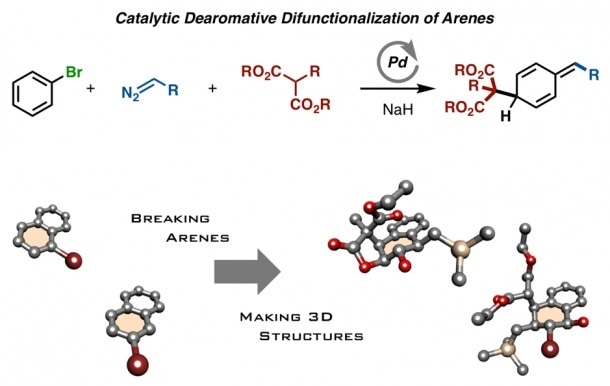Alicyclic compounds are groups of organic chemical compounds that have led to the development of a number of medications, such as those meant for malaria, schizophrenia, and depression.

2D bromoarenes were made to react with diazo compounds and malonates in the presence of a palladium catalyst to yield highly functionalized 3D alicyclic compounds, which are extremely prominent in pharmaceuticals. Image Credit: Junichiro Yamaguchi.
Such compounds are three-dimensional (3D) structures formed when three or more atoms of carbon merge in a ring through covalent bonds; however, this is not an aromatic ring.
Aromatic compounds, also known as arenes, are another group of organic compounds that have 2D structures and reactive characteristics different from those of alicyclic compounds.
Benzene is a well-known example. It is a six-carbon ring containing alternating single-bonds and double-bonds between the atoms of carbon. Alicyclic compounds can be obtained by dearomatizing arenes. As a matter of fact, such a dearomatization is regarded as one of the most robust methods to acquire alicyclic compounds.
However, naphthalene and benzene, which are some of the most abundantly available arenes, are extremely stable, and it has been difficult to break them up to build alicyclic compounds. In the case of prevalent techniques, large quantities of reactants often result in very less product.
“The highly efficient conversion of readily and commercially available arenes to high value-added alicyclic compounds could accelerate drug discovery research by leaps,” stated Assistant Professor Kei Muto and Professor Junichiro Yamaguchi from Japan-based Waseda University, who headed the discovery of the new efficient technique.
The study has been published in Chemical Science, a journal from the Royal Society of Chemistry.
In the latest technique, bromoarenes are allowed to react with two other groups of organic compounds—called malonates and diazo compounds—in the presence of a palladium-based catalyst (a compound that allows a chemical reaction), under favorable conditions of time, temperature, and concentration (experimentally established in the analysis). This method subsequently yields excellent quantities of the corresponding alicyclic compounds.
What is really special about this method is that a range of bromoarenes, including benzenoids, azines, and heteroles, can be converted to their alicyclic counterparts.”
Kei Muto, Assistant Professor, Waseda University
Muto also spoke about the major portions of an alicyclic molecule which give utility and complexity to this molecule; the major portions are the functional groups bound to the cyclic carbons.
The obtained compounds have functional groups at two points in the cyclic chain, and these can be easily diversified through further reactions to yield a variety of highly functionalized 3D molecules.”
Kei Muto, Assistant Professor, Waseda University
This multi-functionalization is enabled by using malonates as a reactant, distinguishing this new technique from other prevalent techniques, which are usually highly specific with respect to the possible products.
Since malonates mainly react with complexes of benzyl and palladium, the application of a palladium-based catalyst turned out to be integral to the success of this technique.
This palladium-based catalyst resulted in the formation of an intermediate of benzyl and palladium that could subsequently react with malonates, creating the ultimate multi-functionalized alicyclic products.
Hence, developing a suitable catalytic procedure was crucial to creating a technique that converts aromatic compounds into alicyclic ones.
Next, we would like to design new catalysts to make this reaction more general; that is, compatible with a broader range of arenes.”
Junichiro Yamaguchi, Professor, Waseda University
With their upcoming plans sketched out, both Muto and Yamaguchi are confident about the positive impact their group’s work can make in this world: “We believe this organic reaction will help drug discovery research finally ‘escape from the flatland’ of the simpler and 2D aromatic compounds, so to speak, thereby advancing medicinal chemistry significantly,” they concluded.
Source:
Journal reference:
Kato, H., et al. (2020) Catalytic three-component C–C bond forming dearomatization of bromoarenes with malonates and diazo compounds. Chemical Science. doi.org/10.1039/D0SC02881A.